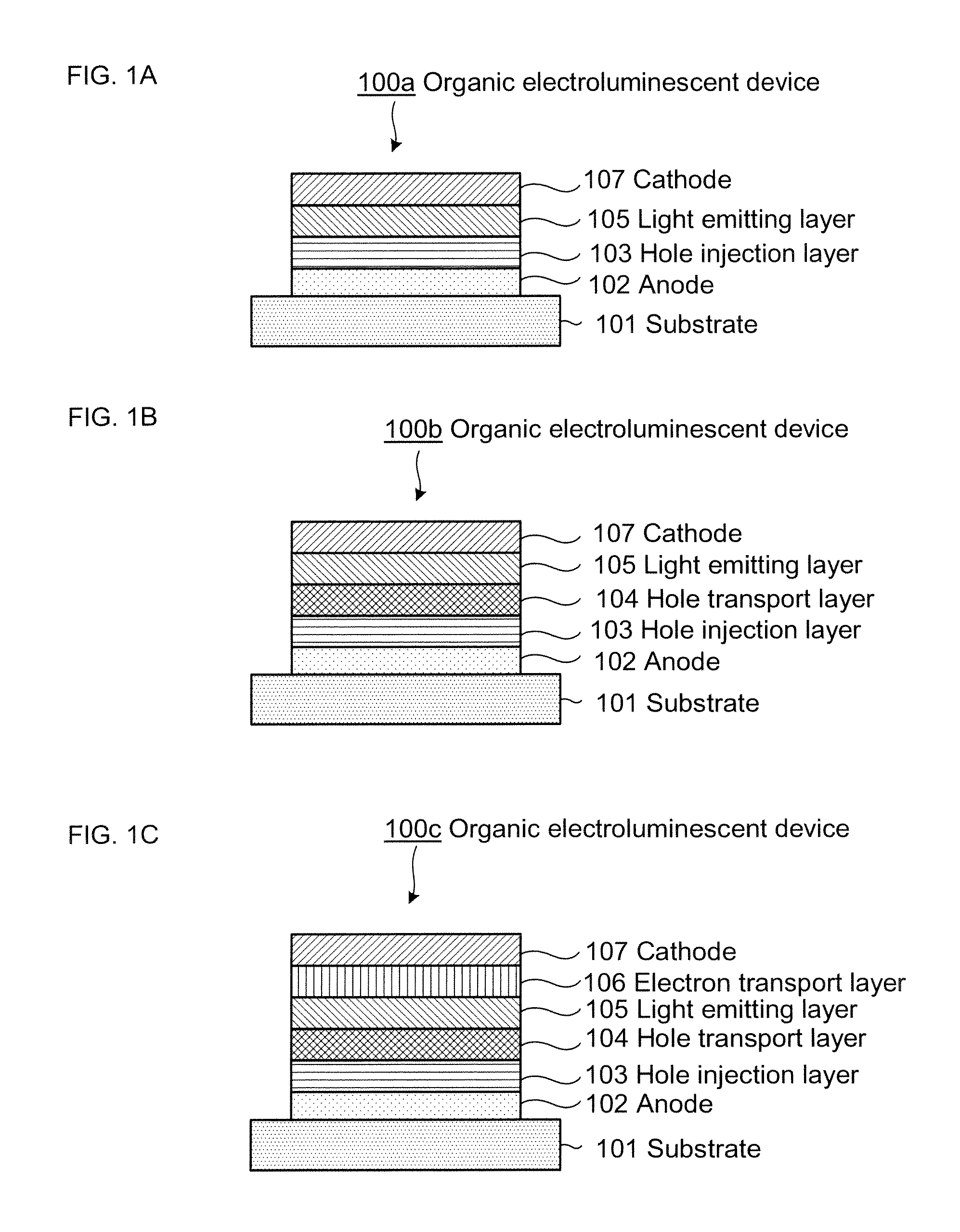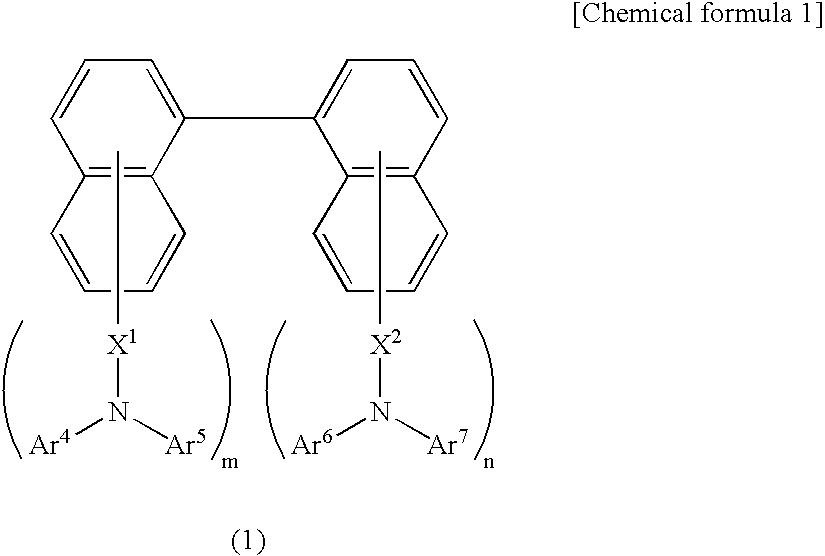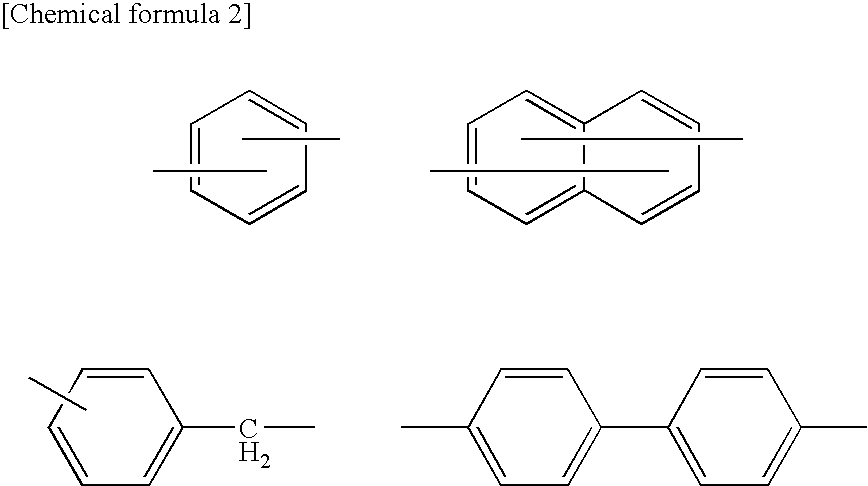Compositions for organic electroluminescent device and organic electroluminescent device
a technology of electroluminescent devices and organic electroluminescent devices, which is applied in the direction of discharge tubes/lamp details, luminescent screens of discharge tubes, natural mineral layered products, etc., can solve the problems of low solvent solubility, difficult preparation of solutions with appropriate concentrations, and difficult preparation of solutions satisfying these two requirements in balance, so as to reduce the deactivation of cation radicals, prevent the change of the properties of the hole injection transport site, and reduce the reduction of the hole injection
- Summary
- Abstract
- Description
- Claims
- Application Information
AI Technical Summary
Benefits of technology
Problems solved by technology
Method used
Image
Examples
reference example 1
[0151] Physical properties of solvents used to prepare the compositions for the organic electroluminescent device where the present embodiments are applied are shown in Table 1.
TABLE 1VaporWaterSurfacepressuresolubilitytensionBoil-(mmHg)(weight %)(dyn / cm)ing(Measurement(Measurement(MeasurementSolvent namepointtemperature)temperature)temperature)(systematic)(° C.)(° C.)(° C.)(° C.)ethyl2130.270.07235.4benzoate(25)(25)(20)(ester)anisole1543.540.1034.2(ether)(25)(25)(30)2-phenoxyethyl2600.01—38.4acetate(20)—(25)(correspondsto both etherand ester)cyclohexanone15659.534.5(ketone)(25)(20)(20)N-methyl2020.34Dissolve41pyrolidone(20)with an(25)(ketone)arbitraryratio (25)
example 1
[0152] A product (manufactured by GEOMATEC Co., Ltd.; film product formed by use of electron beam; sheet resistance 15Ω), which was 120 nm of transparent indium tin oxides (ITO) conductive film deposited on a glass substrate, was subjected to ultrasonic cleaning in acetone, rinsing in pure water, ultrasonic cleaning in isopropyl alcohol, drying in dry nitrogen and UV / ozone cleaning. Subsequently, a composite solution containing a hole transporting polymer (homopolymer: Mw=27000, Mn=13000) shown in a chemical formula (P1) below and tris(pentafluorophenyl)borane (PPB) as an electron acceptor is spin coated onto this glass substrate under conditions described below to form a uniform thin film with a film thickness of 30 nm. Spin coating was carried out in air. Environmental conditions at this time were temperature of 23° C. and relative humidity of 60%. [0153] Solvent ethyl benzoate [0154] Coating solution concentration hole transporting polymer 2 weight % / electron acceptor 0.2 weight...
example 2
[0158] The composite solution containing the hole transporting polymer (P1) and PPB as the electron acceptor is spin coated onto the glass substrate used in Example 1 by similar processes to those of Example 1 under conditions described below to form a uniform thin film with a film thickness of 30 nm. Spin coating was carried out in air. Environmental conditions at this time were temperature of 23° C. and relative humidity of 60%. [0159] Solvent anisole [0160] Coating solution concentration hole transport polymer 1.3 weight % / electron acceptor 0.13 weight % [0161] Spinner revolution 1500 rpm [0162] Spinner revolution time 30 seconds [0163] Drying condition Heat drying at 100° C. for 60 minutes in the oven.
PUM
| Property | Measurement | Unit |
|---|---|---|
| Temperature | aaaaa | aaaaa |
| Temperature | aaaaa | aaaaa |
| Time | aaaaa | aaaaa |
Abstract
Description
Claims
Application Information
 Login to View More
Login to View More - R&D
- Intellectual Property
- Life Sciences
- Materials
- Tech Scout
- Unparalleled Data Quality
- Higher Quality Content
- 60% Fewer Hallucinations
Browse by: Latest US Patents, China's latest patents, Technical Efficacy Thesaurus, Application Domain, Technology Topic, Popular Technical Reports.
© 2025 PatSnap. All rights reserved.Legal|Privacy policy|Modern Slavery Act Transparency Statement|Sitemap|About US| Contact US: help@patsnap.com



